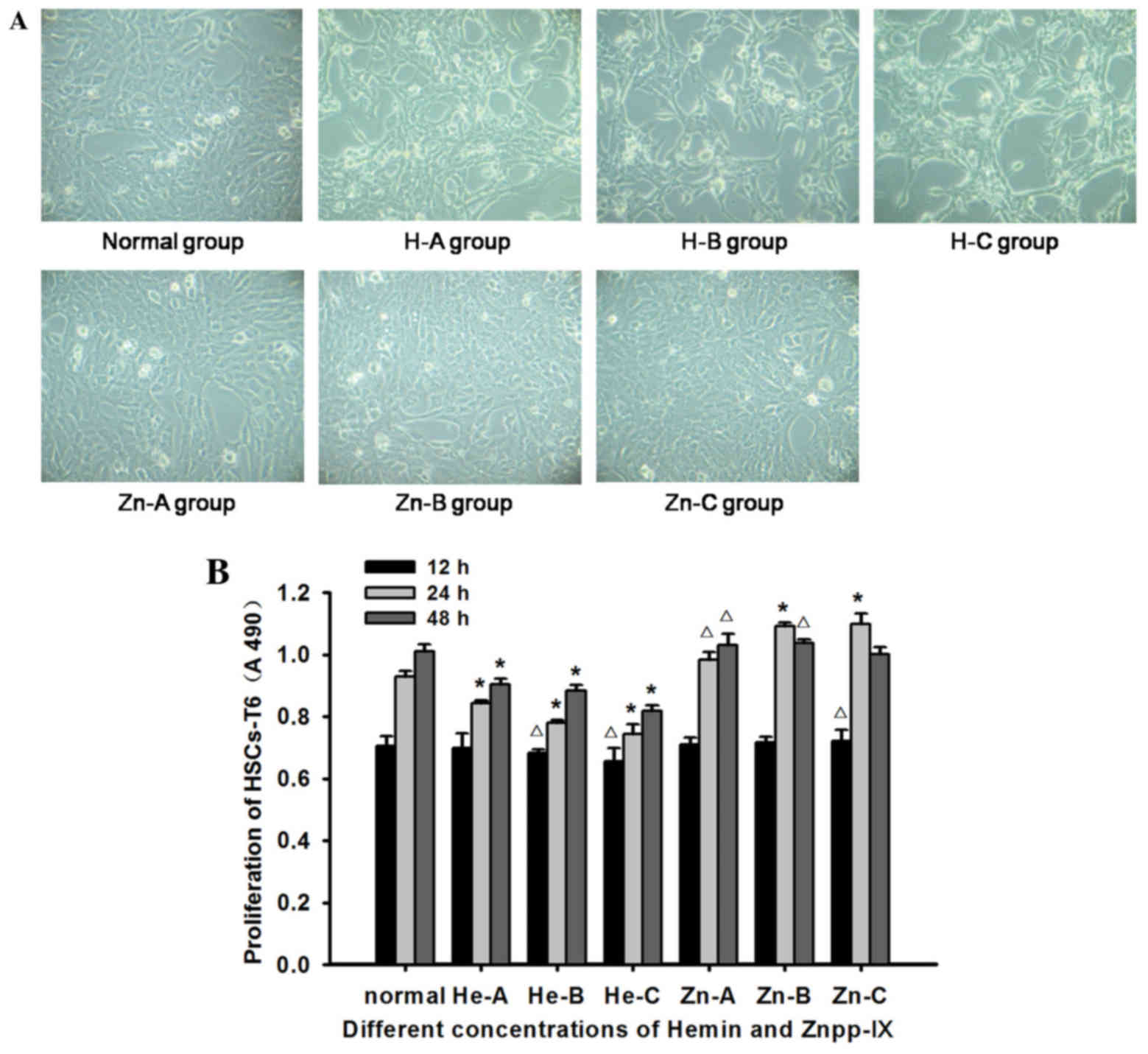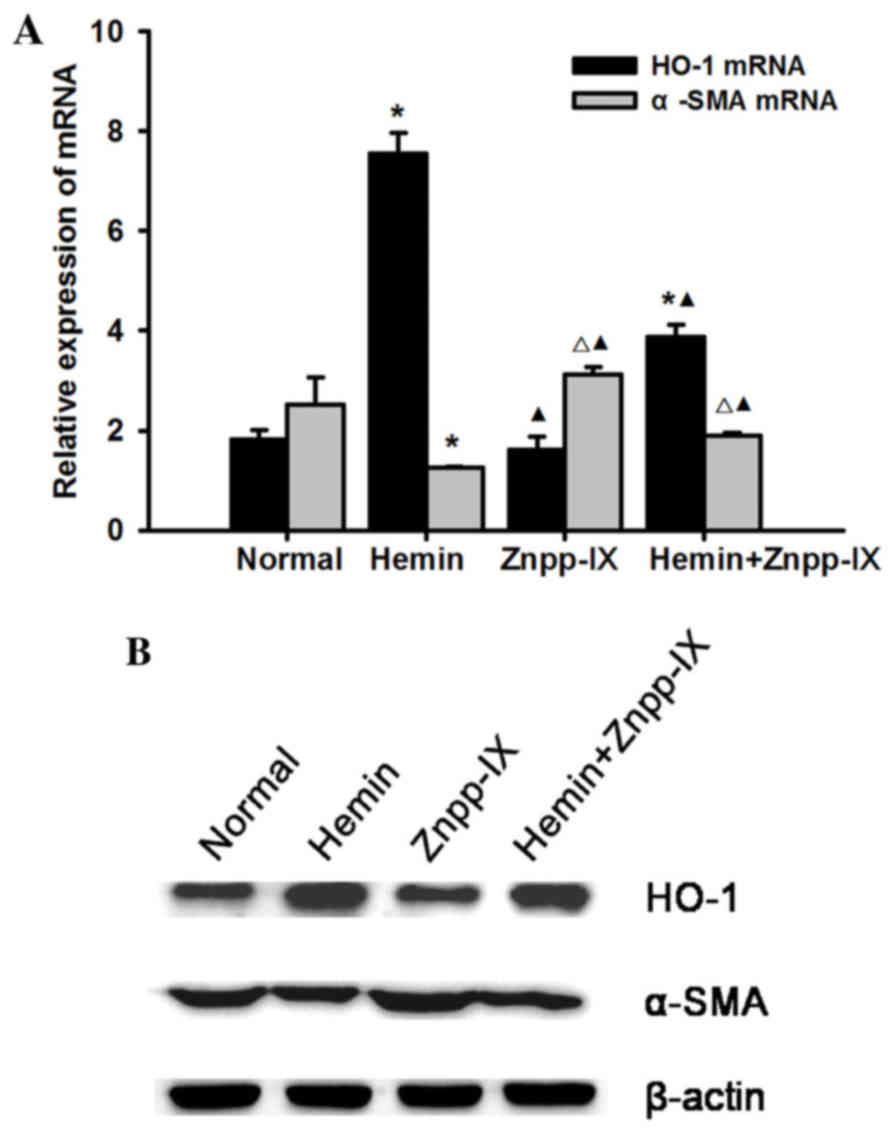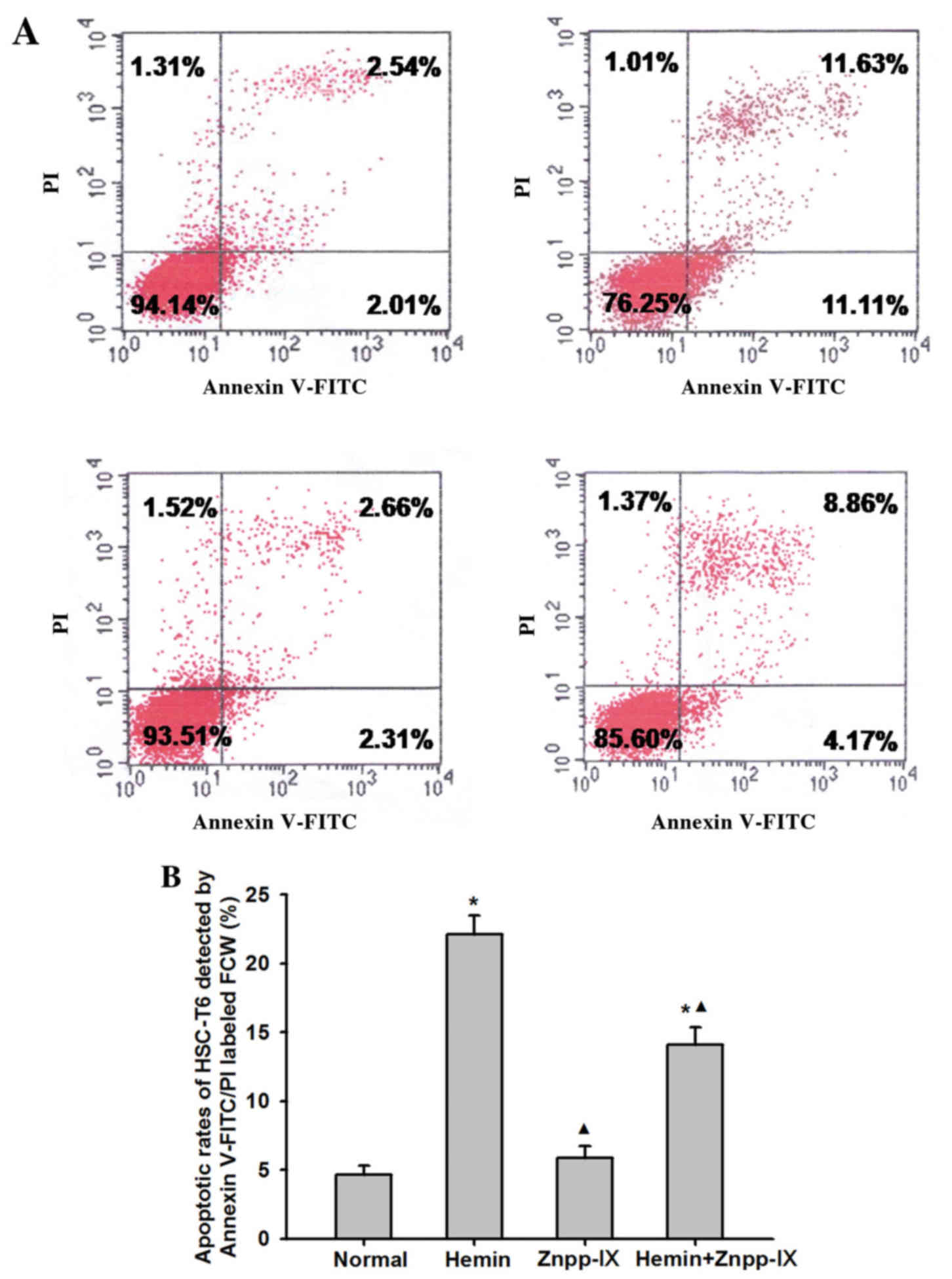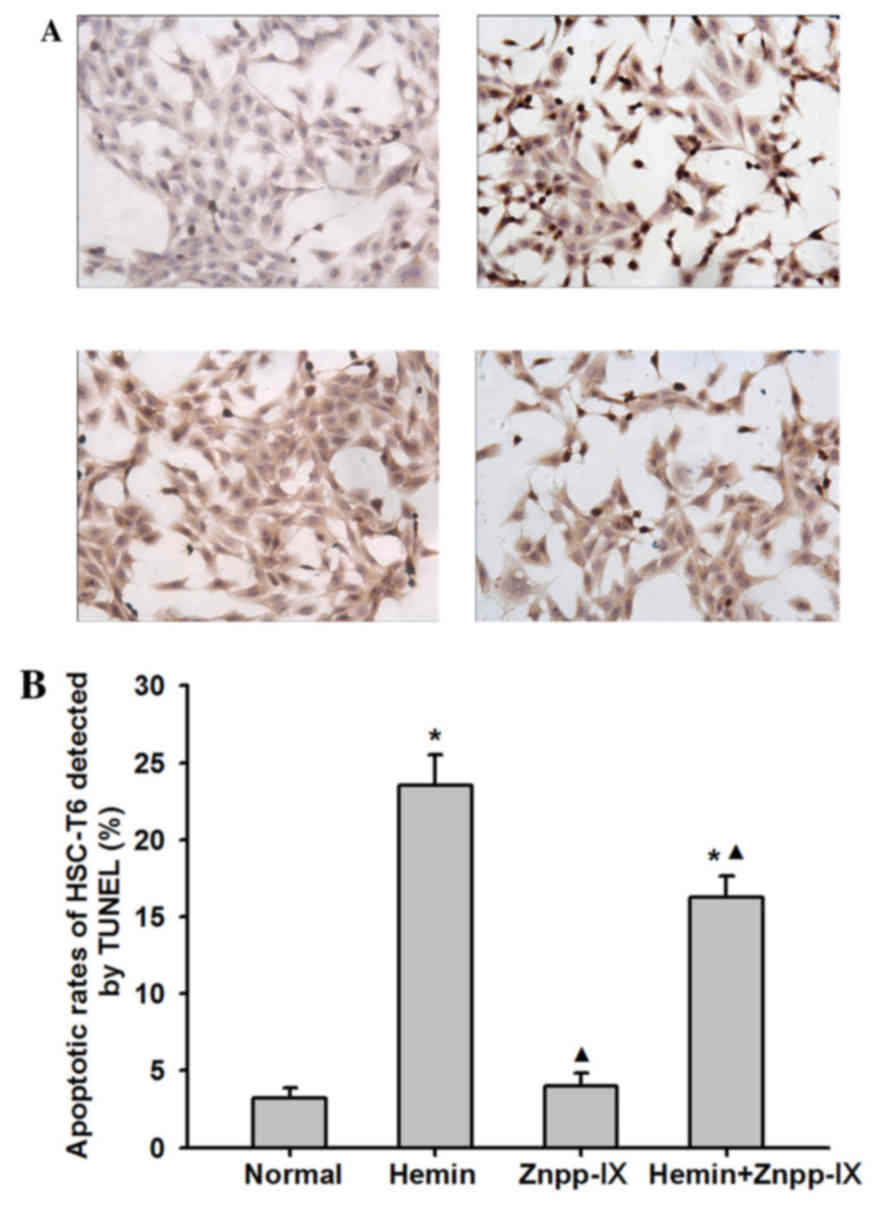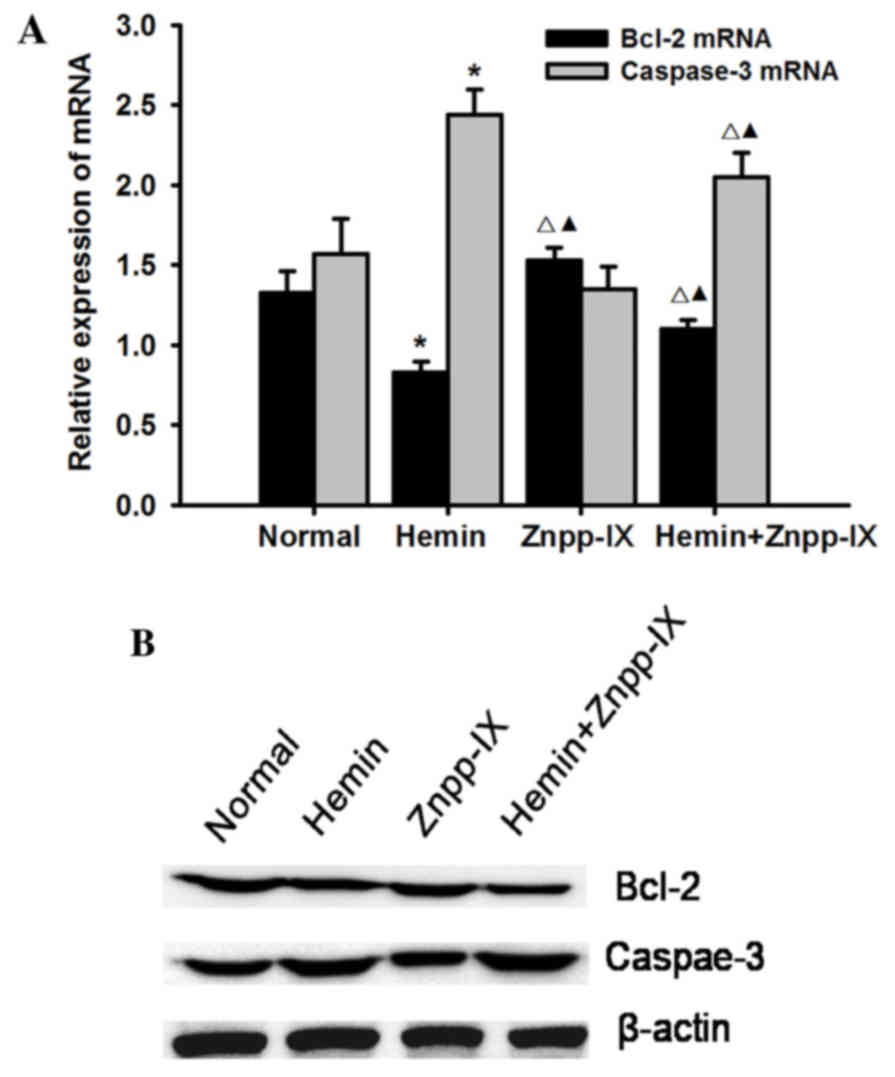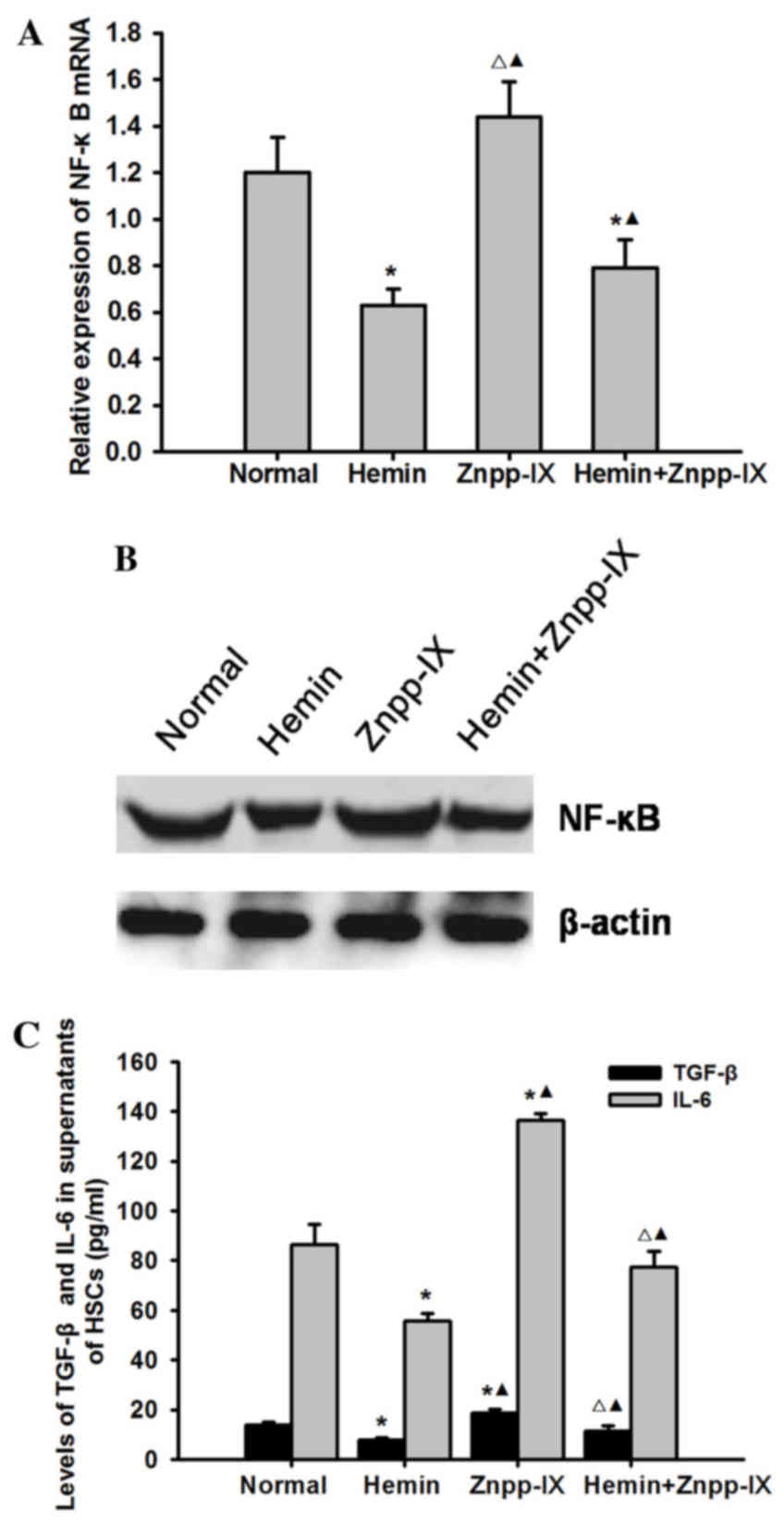Heme oxygenase‑1 exerts pro‑apoptotic effects on hepatic stellate cells in vitro through regulation of nuclear factor‑κB
- Authors:
- Published online on: May 18, 2018 https://doi.org/10.3892/etm.2018.6185
- Pages: 291-299
-
Copyright: © Yang et al. This is an open access article distributed under the terms of Creative Commons Attribution License.
Abstract
Introduction
Hepatic stellate cells (HSCs) play a crucial role in the development of liver fibrosis (1,2). During various types of liver injury, such as that induced by viral infection, immune stimulation and alcohol, HSCs, which are the primary source of extracellular matrix (ECM) and overexpression of α-smooth muscle actin (α-SMA), undergo activation and proliferation, leading to the development of fibrosis due to the abnormal deposition of collagen in the liver (3). Prior research has demonstrated that the reduction of HSC numbers observed during reversion of liver fibrosis is due to the transformation of HSCs from their activated to a stationary state (4). It has also been demonstrated that apoptosis of HSCs is the main mechanism involved in the restoration stage of liver fibrosis, as this inhibits the self-activation of HSCs and decreases the production of ECM (5).
Heme oxygenase-1 (HO-1), also referred to as heat shock protein 32 (Hsp32), is a microsomal rate-limiting enzyme that catalyzes the degradation of heme into biliverdin, iron atoms, and carbon monoxide (CO) (6). HO-1 and its breakdown products possess biological protective properties, including anti-oxidant, anti-inflammatory and immunoregulatory properties (7). HO-1 is closely associated with cell apoptosis, and most studies suggest that HO-1 may regulate apoptosis by affecting the expression of key proteins in the apoptotic signaling pathway (8). In addition, HO-1 appears to exert protective effects on liver cells under adverse conditions, such as in acute liver injury, alcoholic liver disease, liver transplantation and ischemia/reperfusion injury (9–11). In our previous study using rats with cirrhosis induced by carbon tetrachloride (CCl4) as a research model in vivo, we demonstrated that HO-1 upregulation was able to alleviate α-SMA expression, collagen synthesis and liver injury and limit the extent of fibrosis (12). Furthermore, we used activated HSC-T6 as a research model in vitro to demonstrate that the induction of HO-1 can inhibit HSC proliferation and collagen metabolism. However, during the research mentioned above, we noticed that the upregulation of HO-1 led to morphological changes in HSC-T6 cells, such as shrinkage and nuclear condensation (karyopyknosis). Thus, we aimed to investigate whether HO-1 is involved in liver protection by regulating the apoptosis of HSCs, which has not yet been fully elucidated.
This study was undertaken in order to evaluate the role of HO-1 in the apoptosis of activated HSCs-T6 in vitro. Our hypothesis was that HO-1 may induce HSC apoptosis while inhibiting the proliferation of HSCs, which would thus implicate HO-1 as a viable therapeutic target in preventing or reversing liver fibrosis.
Materials and methods
Materials and reagent preparation
Dulbecco's modified Eagle's medium (DMEM) and fetal bovine serum (FBS) were purchased from Invitrogen (Thermo Fisher Scientific, Inc., Waltham, MA, USA). Hemin [ferriprotoporphyrin IX, HO-1 inducer (13)] and zinc protoporyphyrin IX [ZnPP-IX, HO-1 inhibitor (14)] were purchased from Sigma-Aldrich (Merck KGaA, Darmstadt, Germany), and dissolved in 0.2 mol/l NaOH, titrated to pH 7.4 with 1 mol/l HCl and diluted in 0.9% NaCl (15). The dose and preparation of hemin and ZnPP solution were based on the references (16,17). The final concentrations were 1 mg/ml hemin and 0.5 mg/ml ZnPP-IX. Polyclonal antibodies against HO-1, α-SMA, nuclear factor (NF)-κB and caspase-3 were purchased from Cell Signaling Technology, Inc. (Danvers, MA, USA). Monoclonal antibodies against B-cell lymphoma (Bcl)-2 and anti-β-actin polyclonal antibody were purchased from Santa Cruz Biotechnology, Inc. (Dallas, TX, USA). A lactate dehydrogenase (LDH) release assay kit was obtained from Sigma-Aldrich; Merck KGaA. An Annexin V-FITC/PI apoptosis detection kit was purchased from BD Biosciences (Franklin Lakes, NJ, USA). A terminal deoxynucleotidyl transferase dUTP nick-end labeling assay (TUNEL) apoptosis detection kit was purchased from Nanjing Keygen Biotechnology (Nanjing, China).
Cell culture and treatment
Immortalized rat HSC-T6 cells, which were provided by Professor Zhongfu Zhao (Changzhi Medical College, Changzhi, China), were cultured at 37°C in a humidified incubator under a 5% CO2 atmosphere. The cells were passaged every 2 or 3 days and were used for the experiment within 4 to 6 passages. HSC-T6 cells were incubated with hemin at concentrations of 6.5, 13 and 26 µg/ml, and with Znpp-IX at concentrations of 3, 6 and 12 µg/ml for 12, 24 and 48 h.
Cell viability assay
An MTT assay was used to assess HSC-T6 cell viability under different concentrations of hemin and Znpp-IX at 12, 24 and 48 h. HSC-T6 cells were plated at a density of 1×104 cells/well in 96-well plates and cultured at 37°C for 24 h. The medium was then replaced with fresh medium containing hemin or Znpp-IX at different concentrations, as mentioned above. Following incubation for 12, 24 and 48 h, the supernatants were removed and cells were treated with 20 µl MTT solution (5 mg/ml) for 4 h at 37°C. The formazan precipitates were dissolved in 150 µl dimethyl sulfoxide, and optical density (OD) was measured at 490 nm using an enzyme-linked immunometric meter: Cell survival rate=(ODexperimental group-ODblank group)/(ODcontrol group-ODblank group) ×100%.
LDH release assay
In order to determine whether the decrease in HSC proliferative activity was due to apoptosis or necrosis caused by drugs, the cytotoxic effect of hemin or ZnPP-IX on HSC-T6 cells was evaluated using the LDH release assay. Preconfluent HSCs were treated with hemin or ZnPP-IX at the indicated concentrations and for the indicated times. LDH released by necrotic cells was present in the supernatant and determined as LDHn, whereas LDH in precipitates and adherent cell lysates was determined as LDHc. The results are shown as follows: LDHn%=LDHn/(LDHn + LDHc) ×100. Then, treatments with hemin at 13 µg/ml and Znpp-IX at 3 µg/ml for 24 h were applied for subsequent experiments, as these were selected as the concentrations most prominently affecting the proliferation of HSC-T6 cells, without observable toxic cell damage.
Apoptosis quantification by flow cytometry analysis
HSC-T6 cell apoptosis was measured by both flow cytometry Annexin V/FITC and propidium iodide (PI) double staining according to the manufacturer's instructions. HSCs were classified into the control, hemin-treated, Znpp-IX-treated and hemin and Znpp-IX co-treatment groups. After 24 h of treatment, cells were detached with ethylenediaminetetraacetic acid (EDTA)-free trypsin and washed twice with cooled phosphate-buffered saline (PBS), then re-suspended in 500 µl 1X loading buffer with 5 µl Annexin V and 5 µl PI for 15 min at room temperature in the dark. Binding buffer was then added and the cells were analyzed by flow cytometry on a FACSCalibur analyzer. The percentage of Annexin V/FITC+ cells reflected the apoptosis rate.
Qualitative measurement of apoptosis by TUNEL assay
To further investigate the apoptosis of HSC-T6 cells, a TUNEL assay was used. Preconfluent HSCs cultured in plates were placed on sterile coverslips and treated with hemin or Znpp-IX, grouped as mentioned above, for 24 h. Three replicates were made for each group. The cells were washed with cold PBS three times before fixation. Apoptotic HSCs were detected with the TUNEL Apoptosis Assay kit, according to the manufacturer's protocol. The results were expressed as apoptosis index: Apoptosis index=(number of apoptotic cells/total number of cells) ×100%.
RNA isolation and reverse transcription-quantitative polymerase chain reaction (RT-qPCR) analysis of apoptosis-related genes
The effects of HO-1 on the mRNA level of NF-κB, Bcl-2 and caspase-3 were measured by RT-qPCR. RNA was isolated using TRI Reagent (Sigma-Aldrich; Merck KGaA), according to the manufacturer's instructions. RT was performed on total RNA using random monomers in a final volume of 50 µl. RT was performed in three steps: 10 min at 25°C, 1 h at 37°C and 5 min at 95°C. Quantitative detection was performed on the ABI PRISM 7700 (PE Applied Biosystems, Nieuwerkerk a/d Ijssel, The Netherlands) initialized by 10 min at 95°C, followed by 40 cycles (15 sec at 95°C, and 1 min at 60°C). Each sample was analyzed in duplicate. The relative number of mRNA transcripts was normalized against β-actin using the 2−ΔΔCq method. The specific primer sequences are listed in Table I.
Western blot analysis of apoptosis-related proteins
The effect of HO-1 on the protein levels of NF-κB, Bcl-2 and caspase-3 was measured by western blotting. Approximately 2×107 HSCs-T6 from each group were collected. The proteins were extracted using radioimmunoprecipitation assay buffer and loaded on SDS-PAGE gels, then transferred onto PVDF membranes, which were blocked with 5% bovine serum albumin in TBST buffer overnight at 4°C. Subsequently, the membranes were incubated with the following primary antibodies: anti-HO-1 polyclonal antibody at 1:1,000 dilution, anti-NF-κB p65 polyclonal antibody at 1:800 dilution, anti-α-SMA polyclonal antibody at 1:1,000 dilution, anti-Bcl-2 monoclonal antibody at 1:1,000 dilution, anti-caspase-3 polyclonal antibody at 1:800 dilution and anti-β-actin polyclonal antibody at 1:4,000 dilution overnight at 4°C. The membranes were then treated with a horseradish peroxidase-conjugated secondary antibody. The blots were visualized using a Super ECL detection kit (Amersham Pharmacia Biotech, Piscataway, NJ, USA), according to the manufacturer's instructions. Protein bands were detected using a Kodak Digital Science Imaging System (Kodak, Rochester, NY, USA).
ELISA analysis for inflammatory cytokines
To measure the secretion of cytokines from HSCs, 1×105/ml cells/well were cultured for 24 h in a 6-well plate, then changed to serum-free medium to starve for 12 h. The cells were further incubated with hemin or Znpp-IX, as mentioned above, for 24 h. The levels of secreted inflammatory cytokines in the supernatants were determined by ELISA (Quantikine Cytokine kits; R&D Systems, Inc., Minneapolis, MN, USA) according to the manufacturer's instructions. Each treatment was performed in triplicate. The OD of each well was determined using a microplate reader at 450 nm. The cytokine levels were derived from standard curves using the curve-fitting program SOFTmax.
Statistical analysis
The quantitative data were expressed as mean ± standard deviation. Levene was used in test for homogeneity of variances. Comparisons between groups were tested by one-way ANOVA and a post hoc LSD test. P<0.05 was considered to indicate a statistically significant difference.
Results
Observation of HSC growth
The morphology of HSCs-T6 in each concentration of hemin or Znpp-IX at 12 h exhibited no significant changes compared with that of the normal controls. However, at 24 h, the number of HSCs was reduced with increasing concentrations of hemin. The cells were shrunk and rounded, had started to aggregate into clusters, and the transparency of the cytoplasm was decreased. These changes were more obvious at 48 h, particularly in the 13- and 26-µg/ml groups, where cell fragments floating in the supernatant were also observed. Znpp-IX treatment at all concentrations for 24 h markedly improved HSC growth and proliferation, and the cells almost completely covered the bottom of culture flask (Fig. 1A). However, at 48 h in the 6- and 12-µg/ml groups, the cells had become slender, smaller in size, and larger in pectin cavity, with cell fragments floating in the supernatant.
HO-1-induced inhibition of HSC proliferation
The proliferation of HSCs following hemin and Znpp-IX treatment was determined by MTT assay. As shown in Fig. 1B, compared with normal control, hemin caused a dose- and time-dependent reduction in cell proliferation. In particular, HSC proliferation had decreased significantly at 24 and 48 h for all concentrations of hemin (P<0.01). In the Znpp-IX treated group, HSC proliferation increased with increasing dosage and treatment time. HSC survival at 12 h in the 12 µg/ml group and at 24 h in all concentrations was significantly different from normal control (P<0.05). However, at 48 h, HSC proliferation exhibited a small decrease in the 12 µg/ml group. The toxic effect of hemin and Znpp-IX on HSCs was carefully studied with LDH release assays. As shown in Table II, cells treated with hemin 26 µg/ml at 24 h and all concentrations at 48 h, and with Znpp-IX 12 µg/ml at 24 and 48 h and 6 µg/ml at 48 h, exhibited a significant difference in LDH release compared with the normal control. Therefore, based on these observations, hemin at 13 µg/ml and Znpp-IX at 3 µg/ml for 24 h were selected for the apoptosis analysis.
Effects of HO-1 on the expression of α-SMA in HSC-T6 cells
Under treatment with hemin and Znpp-IX, the HO-1 mRNA and protein expression levels were detected as follows: HO-1 expression increased significantly following 13 µg/ml hemin treatment compared with the normal control (P<0.01); it was the lowest in the Znpp-IX group (P<0.05), while it was increased in the hemin + Znpp-IX group compared with the Znpp-IX group (P<0.01), but remained lower by 48.7% compared with that in the hemin group (P<0.01). α-SMA is an important marker of HSC activation and proliferation. The expression of α-SMA mRNA in the HO-1 overexpression group decreased significantly compared with the normal control (P<0.01), but the strongest expression was observed in the Znpp-IX group (P<0.05). The results of the protein expression were consistent with the mRNA levels, suggesting that HO-1 induction in HSCs may decrease the expression of α-SMA, with a decrease in HSC proliferative activity (Fig. 2).
Effects of HO-1 on apoptosis of activated HSCs
To determine whether the decrease in HSC proliferation observed in hemin-treated groups was consistent with the induction of apoptosis, we examined the rate of HSC apoptosis using Annexin V-FITC/PI labeling. As shown in Fig. 3, the apoptosis rate of HSCs in the normal control group treated with saline for 24 h was 4.67±0.63%, whereas in the hemin group it was 22.11±1.38%, which was 3.73 times higher (P<0.01). In the hemin + Znpp-IX group the apoptosis rate was 14.07±1.28%, which was 2.01 times higher compared with the normal control (P<0.01), but lower compared with that in the hemin group (P<0.01). The apoptosis rate in the Znpp-IX group did not differ significantly from that in the normal control group (P=0.435).
A TUNEL assay was performed to further evaluate the role of HO-1 in HSC apoptosis. As shown in Fig. 4, the apoptotic index of HSCs in the hemin group was 23.5±2.02%, which was significantly higher compared with that in the normal control group (P<0.01), whereas in the Znpp-IX group it was 4±0.82% (P<0.01). In the hemin + Znpp-IX group, the apoptosis index was 16.25±1.38%, which was still lower compared with that in the hemin group (P<0.01). These results indicated that the inhibitory effect of HO-1 on HSC proliferation was accompanied by promotion of HSC apoptosis.
Effects of HO-1 on the expression of Bcl-2 and caspase-3
To further investigate the involvement of hemin in cell apoptosis, the expression of Bcl-2 and caspase-3 was measured. Bcl-2 is an antiapoptotic protein, and its expression at the mRNA and protein levels was detected as shown in Fig. 5: Bcl-2 expression in the hemin group was significantly decreased compared with that in the normal control group (P<0.05), while in the hemin + Znpp-IX group it was higher compared with that in the hemin group (P<0.05). Bcl-2 expression in the Znpp-IX group was the highest (P<0.05) compared with other groups.
Caspase-3 plays a key role in the execution phase of cell apoptosis. HO-1 overexpression significantly increased the mRNA and protein expression of caspase-3 (P<0.01) in the hemin group, while it was significantly decreased in the hemin + Znpp-IX group (P<0.05) and was the lowest in the Znpp-IX group. Taken together, these results indicated that the regulation of HSC apoptosis by HO-1 overexpression is mediated by inhibition of Bcl-2 and induction of caspase-3.
Effects of HO-1 on the expression of NF-κB p65 and its downstream inflammatory factors TGF-β and interleukin (IL)-6
To elucidate the possible mechanism underlying the effect of HO-1 on HSC apoptosis, we examined the mRNA and protein expression of NF-κB p65 and its downstream inflammatory factors TGF-β and IL-6 in each experimental group. As shown in Fig. 6, the mRNA and protein expression of NF-κB p65 in the hemin group was significantly decreased (P<0.05), while in the hemin + Znpp-IX co-treatment group it was significantly increased (P<0.05) compared with the hemin group, but was highest in the Znpp-IX group (P<0.05). The levels of TGF-β and IL-6 in the HSC supernatants were consistent with NF-κB p65, also decreasing after hemin treatment (P<0.05) while increasing after ZnPP-IX treatment.
Discussion
The present study demonstrated that regulation of HSC activity is key to delaying or reversing hepatic fibrosis. During the development of hepatic fibrosis, the numbers of HSCs increase significantly, due to the proliferation of activated cells and relative inhibition of apoptosis (18). HSC apoptosis, as a potential regulatory mechanism, significantly reduces the level of specific tissue inhibitors of matrix metalloproteinases synthesized by activated HSCs, and increases the degradation of ECM components, so as to prevent the progression of hepatic fibrosis, or even reverse this process (19). Therefore, inducing apoptosis of activated HSCs is one of the major strategies in the study of prevention of hepatic fibrosis.
HO-1 has anti-inflammatory and anti-oxidant properties, and is involved in the regulation of apoptosis. HO-1 was shown to markedly affect the cell cycle in renal epithelial cells by upregulating the expression of p21, leading to alterations in cell growth pattern and resistance to apoptosis (20). Induction of HO-1 was found to protect endothelial cells from undergoing apoptosis, mediated through heme catabolism into CO by the p38 mitogen-activated protein kinase signal transduction pathway (21). HO-1 also plays a protective role in preventing nutritional steatohepatitis through suppressing hepatocyte apoptosis in mice by upregulating the expression of anti-apoptosis genes and downregulating pro-apoptosis genes (22). Interestingly, previous findings suggested that HO-1 may also induce apoptosis. Aung et al suggested that high-dose DEHP exposure induces caspase-3-dependent apoptosis in Neuro-2a cells, which was mediated by the upregulation of the HO-1 gene (23). The study of Liu et al on the biological role of HO-1 in vascular smooth muscle cells (SMCs) demonstrated that infection of SMCs with AdHO-1 inhibited serum-stimulated SMC proliferation and stimulated SMC apoptosis in a dose-dependent manner, as demonstrated by DNA fragmentation and caspase-3 activation (24); they also found that HO-1-mediated apoptosis was associated with a marked increase in the expression of the pro-apoptotic protein p53. In addition, HO-1 has been reported to induce apoptosis and suppress proliferation and invasion in breast cancer cells (25,26). HO-1 was also found to be the key protein involved in determining the selective effect on cancer cell apoptosis (27). It was first reported that piperlongumine induced breast cancer cell apoptosis through the upregulation of HO-1 expression, while protecting normal cells from piperlongumine-induced apoptosis.
Our previous study demonstrated that HO-1 upregulation decreased α-SMA expression, collagen synthesis, liver injury and the development of fibrosis in a rat model of CCl4-induced liver fibrosis (12), which was correlated with the expression of PPAR and NF-κB in liver tissues. In the present study, we further demonstrated that the induction of HO-1 reduced the proliferation and activation of HSC-T6 cells in vitro and decreased the expression of α-SMA. It was observed that hemin (a selective HO-1 inducer) inhibited the proliferation and activation of HSCs in a time- and dose-dependent manner; in addition, morphological changes reflecting a decrease in the growth of HSCs were observed under a light microscope, such as group clustering, volume reduction and karyopyknosis. Similarly, the group treated with ZnPP-IX (an inhibitor of HO-1) exhibited increased HSC proliferation with increasing treatment time and higher concentration. The growth of HSCs under the microscope was vigorous and folded together on the bottom of the flask. Based on these results, we hypothesized that HO-1 may be involved in the regulation of HSC apoptosis. To confirm this hypothesis, the TUNEL assay demonstrated that HO-1 induction promoted HSC apoptosis with volume reduction, spindled or crescent-shaped cells, karyopyknosis and clustered accumulation. Additionally, Annexin V/FITC and PI double-label flow cytometry was used to detect HSC apoptosis and the results were consistent with those of the TUNEL assay.
Bcl-2 is an anti-apoptotic protein that acts by reducing the permeability of the mitochondrial membrane and inhibiting mitochondrial depolarization and cytochrome C release (28). Our study demonstrated that Bcl-2 expression decreased in HSCs in the HO-1 upregulation group by hemin, recovered in the hemin + Znpp-IX co-treatment group, and increased in the Znpp-IX group, suggesting that the anti-apoptosis protein Bcl-2 was involved in the regulatory effect of HO-1 on HSC apoptosis. Caspase-3 is considered to be the major protein in the apoptotic cascade reaction, which is closely associated with the apoptosis of HSCs. Various drugs induce HSC apoptosis by activation of caspase-3 (29). We observed that the expression of caspase-3 increased with the upregulation of HO-1 in HSCs, but decreased in the Znpp-IX group. These results indicate that caspase-3 was also involved in the regulation of HSC apoptosis by HO-1.
NF-κB, a gene pleiotropism transcription factor, can activate gene transcription in a number of cell processes, including the inflammatory response, cell proliferation, differentiation and apoptosis (30). Numerous studies have demonstrated that the activity of NF-κB increases in HSCs during liver fibrosis, resulting in increased expression of inflammatory factors, such as TNF-α, IL-6, ICAM-1 and TGF-β, amplifying the inflammatory reaction of the liver (29). Increased activity of NF-κB can also upregulate its downstream target genes, such as COX-2, cyclin D1 and Bcl-2, while inhibiting the activation of caspase-3 to inhibit apoptosis (31,32). Accumulating data indicate that the promoter region of HO-1 has binding sites for NF-κB, and that the action of HO-1 is directly associated with NF-κB (33). Zhang et al reported that the protective effect of HO-1 against intestinal barrier dysfunction in cholestatic liver injury was associated with NF-κB inhibition (34). Yeh et al suggested that HO-1 activation may decrease myocardial ischemia-reperfusion injury with cardioplegia during cardiopulmonary bypass via inhibition of NF-κB and AP-1 translocation (35). So et al reported that flunarizine attenuates cisplatin-induced pro-inflammatory cytokine secretion and cyototoxicity through the downregulation of NF-κB by Nrf2/HO-1 activation (36). In our previous research, we also found that HO-1 upregulation decreased the inflammation and pathological damage of liver tissues in rats with hepatic fibrosis, while the expression of NF-κB in the liver was markedly reduced. Consistent with these findings, in order to elucidate the possible mechanisms underlying the regulation of HSC apoptosis by HO-1, we examined the expression of NF-κB p65 and its downstream inflammatory factors TGF-β and IL-6 in each experimental group. Our results clearly demonstrated that HO-1 upregulation was able to reduce the expression of NF-κB p65 and the release of TGF-β and IL-6, whereas co-treatment with Znpp-IX alleviated these inhibitory effects. By contrast, treatment of Znpp-IX alone exerted the opposite effects.
The findings of the present study suggested that the anti-fibrosis effects of HO-1 on activated HSCs were mediated by inhibiting the proliferation of HSCs, and also through promoting the apoptosis of HSCs by regulating the expression of apoptosis-related proteins, such as Bcl-2 and caspase-3. This was inconsistent with the majority of previous studies that suggested HO-1 and its metabolites play a major inhibitory role in the regulation of apoptosis. In combination with our previous animal experiments, we further confirmed that HO-1 promoted HSC apoptosis by attenuating the expression of NF-κB and its downstream signaling molecules in HSCs. This indirect regulation may be advantageous to the direct regulation of HO-1 itself and its metabolites on the apoptosis-related pathway and protein expression in HSCs. Thus, the protective role of HO-1 may be considered as a potential candidate in the prevention of liver fibrosis, although further experiments are required to clearly determine its role and potential applications in liver diseases.
Acknowledgements
The authors would like to thank Dr Adelina Hung (Yale University School of Medicine) for the English language editing of this manuscript.
Funding
This study was supported by the International Technology Cooperation Project of Shanxi Province (grant no. 2014081053-2) and the Foundation of Health and Family Planning Commission of Shanxi Province (grant no. 201601030).
Availability of data and materials
All data generated or analyzed during this study are included in this published article.
Authors' contributions
HY, LoZ and ZZ designed the study. LiZ, JC, XiaoqZ and XiaohZ performed the experiments. BC and YZ analysed the data. HY wrote the manuscript.
Ethics approval and consent to participate
Not applicable.
Consent for publication
Not applicable.
Competing interests
The authors declare that they have no competing interests.
References
|
She H, Xiong S, Hazra S and Tsukamoto H: Adipogenic transcriptional regulation of hepatic stellate cells. J Biol Chem. 280:4959–4967. 2005. View Article : Google Scholar : PubMed/NCBI | |
|
Lee SH, Seo GS, Park YN and Sohn DH: Nephroblastoma overexpressed gene (NOV) expression in rat hepatic stellate cells. Biochem Pharmacol. 68:1391–1400. 2004. View Article : Google Scholar : PubMed/NCBI | |
|
Melhem A, Muhanna N, Bishara A, Alvarez CE, Ilan Y, Bishara T, Horani A, Nassar M, Friedman SL and Safadi R: Anti-fibrotic activity of NK cells in experimental liver injury through killing of activated HSC. J Hepatol. 45:60–71. 2006. View Article : Google Scholar : PubMed/NCBI | |
|
Burt AD: C. L. Oakley Lecture (1993). Cellular and molecular aspects of hepatic fibrosis. J Pathol. 170:105–114. 1993. View Article : Google Scholar : PubMed/NCBI | |
|
Di Sario A, Bendia E, Baroni Svegliati G, Ridolfi F, Casini A, Ceni E, Saccomanno S, Marzioni M, Trozzi L, Sterpetti P, et al: Effect of pirfenidone on rat hepatic stellate cell proliferation and collagen production. J Hepatol. 37:584–591. 2002. View Article : Google Scholar : PubMed/NCBI | |
|
Araujo JA, Zhang M and Yin F: Heme oxygenase-1, oxidation, inflammation, and atherosclerosis. Front Pharmacol. 3:1192012. View Article : Google Scholar : PubMed/NCBI | |
|
Gozzelino R, Jeney V and Soares MP: Mechanisms of cell protection by heme oxygenase-1. Annu Rev Pharmacol Toxicol. 50:323–354. 2010. View Article : Google Scholar : PubMed/NCBI | |
|
Kim KM, Im AR, Lee S and Chae S: Dual protective effects of flavonoids from petasites japonicus against UVB-induced apoptosis mediated via HSF-1 activated heat shock proteins and Nrf2-activated heme oxygenase-1 pathways. Biol Pharm Bull. 40:765–773. 2017. View Article : Google Scholar : PubMed/NCBI | |
|
Lijie Z, Ranran F, Xiuying L, Yutang H, Bo W and Tao M: Soyasaponin Bb protects rat hepatocytes from alcohol-induced oxidative stress by inducing heme oxygenase-1. Pharmacogn Mag. 12:302–306. 2016. View Article : Google Scholar : PubMed/NCBI | |
|
Park SW, Kang JW and Lee SM: The role of heme oxygenase-1 in drug metabolizing dysfunction in the alcoholic fatty liver exposed to ischemic injury. Toxicol Appl Pharmacol. 292:30–39. 2016. View Article : Google Scholar : PubMed/NCBI | |
|
Wu B, Song HL, Yang Y, Yin ML, Zhang BY, Cao Y, Dong C and Shen ZY: Improvement of liver transplantation outcome by heme oxygenase-1-transduced bone marrow mesenchymal stem cells in rats. Stem Cells Int. 2016:92350732016. View Article : Google Scholar : PubMed/NCBI | |
|
Yang H, Zhao LF, Zhao ZF, Wang Y, Zhao JJ and Zhang L: Heme oxygenase-1 prevents liver fibrosis in rats by regulating the expression of PPARγ and NF-κB. World J Gastroenterol. 18:1680–1688. 2012. View Article : Google Scholar : PubMed/NCBI | |
|
Supinski GS and Callahan LA: Hemin prevents cardiac and diaphragm mitochondrial dysfunction in sepsis. Free Radic Biol Med. 40:127–137. 2006. View Article : Google Scholar : PubMed/NCBI | |
|
Liu H, Song D and Lee SS: Role of heme oxygenase-carbon monoxide pathway in pathogenesis of cirrhotic cardiomyopathy in the rat. Am J Physiol Gastrointest Liver Physiol. 280:G68–G74. 2001. View Article : Google Scholar : PubMed/NCBI | |
|
Martasek P, Schwartzman ML, Goodman AI, Solangi KB, Levere RD and Abraham NG: Hemin and L-arginine regulation of blood pressure in spontaneously hypertensive rats. J Am Soc Nephrol. 2:1078–1084. 1991.PubMed/NCBI | |
|
Hualin C, Wenli X, Dapeng L, Xijing L, Xiuhua P and Qingfeng P: The anti-inflammatory mechanism of heme oxygenase-1 induced by hemin in primary rat alveolar macrophages. Inflammation. 35:1087–1093. 2012. View Article : Google Scholar : PubMed/NCBI | |
|
Choi KM, Gibbons SJ, Nguyen TV, Stoltz GJ, Lurken MS, Ordog T, Szurszewski JH and Farrugia G: Heme oxygenase-1 protects interstitial cells of Cajal from oxidative stress and reverses diabetic gastroparesis. Gastroenterology. 135:2055–2064. 2008. View Article : Google Scholar : PubMed/NCBI | |
|
Li X, Wang Y, Wang H, Huang C, Huang Y and Li J: Endoplasmic reticulum stress is the crossroads of autophagy, inflammation, and apoptosis signaling pathways and participates in liver fibrosis. Inflamm Res. 64:1–7. 2015. View Article : Google Scholar : PubMed/NCBI | |
|
Gressner AM: The up-and-down of hepatic stellate cells in tissue injury: Apoptosis restores cellular homeostasis. Gastroenterology. 120:1285–1288. 2001. View Article : Google Scholar : PubMed/NCBI | |
|
Inguaggiato P, Gonzalez-Michaca L, Croatt AJ, Haggard JJ, Alam J and Nath KA: Cellular overexpression of heme oxygenase-1 up-regulates p21 and confers resistance to apoptosis. Kidney Int. 60:2181–2191. 2001. View Article : Google Scholar : PubMed/NCBI | |
|
Soares MP, Usheva A, Brouard S, Berberat PO, Gunther L, Tobiasch E and Bach FH: Modulation of endothelial cell apoptosis by heme oxygenase-1-derived carbon monoxide. Anti oxid Redox Signal. 4:321–329. 2002. View Article : Google Scholar | |
|
Nan Y, Wang R, Zhao S, Han F, Wu WJ, Kong L, Fu N, Kong L and Yu J: Heme oxygenase-1 prevents non-alcoholic steatohepatitis through suppressing hepatocyte apoptosis in mice. Lipids Health Dis. 9:1242010. View Article : Google Scholar : PubMed/NCBI | |
|
Aung KH, Win-Shwe TT, Kanaya M, Takano H and Tsukahara S: Involvement of hemeoxygenase-1 in di(2-ethylhexyl) phthalate (DEHP)-induced apoptosis of Neuro-2a cells. J Toxicol Sci. 39:217–229. 2014. View Article : Google Scholar : PubMed/NCBI | |
|
Liu XM, Chapman GB, Wang H and Durante W: Adenovirus-mediated heme oxygenase-1 gene expression stimulates apoptosis in vascular smooth muscle cells. Circulation. 105:79–84. 2002. View Article : Google Scholar : PubMed/NCBI | |
|
Lin CW, Shen SC, Hou WC, Yang LY and Chen YC: Heme oxygenase-1 inhibits breast cancer invasion via suppressing the expression of matrix metalloproteinase-9. Mol Cancer Ther. 7:1195–1206. 2008. View Article : Google Scholar : PubMed/NCBI | |
|
Lee WY, Chen YC, Shih CM, Lin CM, Cheng CH, Chen KC and Lin CW: The induction of heme oxygenase-1 suppresses heat shock protein 90 and the proliferation of human breast cancer cells through its byproduct carbon monoxide. Toxicol Appl Pharmacol. 274:55–62. 2014. View Article : Google Scholar : PubMed/NCBI | |
|
Lee HN, Jin HO, Park JA, Kim JH, Kim JY, Kim B, Kim W, Hong SE, Lee YH, Chang YH, et al: Heme oxygenase-1 determines the differential response of breast cancer and normal cells to piperlongumine. Mol Cells. 38:327–335. 2015. View Article : Google Scholar : PubMed/NCBI | |
|
Mòdol T, Brice N, de Galarreta Ruiz M, Garzón García A, Iraburu MJ, Martínez-Irujo JJ and López-Zabalza MJ: Fibronectin peptides as potential regulators of hepatic fibrosis through apoptosis of hepatic stellate cells. J Cell Physiol. 230:546–553. 2015. View Article : Google Scholar : PubMed/NCBI | |
|
Elsharkawy AM and Mann DA: Nuclear factor-kappaB and the hepatic inflammation-fibrosis-cancer axis. Hepatology. 46:590–597. 2007. View Article : Google Scholar : PubMed/NCBI | |
|
Uwagawa T and Yanaga K: Effect of NF-κB inhibition on chemoresistance in biliary-pancreatic cancer. Surg Today. 45:1481–1488. 2015. View Article : Google Scholar : PubMed/NCBI | |
|
Kucharczak J, Simmons MJ, Fan Y and Gélinas C: To be, or not to be: NF-kappaB is the answer-role of Rel/NF-kappaB in the regulation of apoptosis. Oncogene. 22:8961–8982. 2003. View Article : Google Scholar : PubMed/NCBI | |
|
Son G, Iimuro Y, Seki E, Hirano T, Kaneda Y and Fujimoto J: Selective inactivation of NF-kappaB in the liver using NF-kappaB decoy suppresses CCl4-induced liver injury and fibrosis. Am J Physiol Gastrointest Liver Physiol. 293:G631–G639. 2007. View Article : Google Scholar : PubMed/NCBI | |
|
Lin CC, Chiang LL, Lin CH, Shih CH, Liao YT, Hsu MJ and Chen BC: Transforming growth factor-beta1 stimulates heme oxygenase-1 expression via the PI3K/Akt and NF-kappaB pathways in human lung epithelial cells. Eur J Pharmacol. 560:101–109. 2007. View Article : Google Scholar : PubMed/NCBI | |
|
Zhang L, Zhang Z, Liu B, Jin Y, Tian Y, Xin Y and Duan Z: The protective effect of heme oxygenase-1 against intestinal barrier dysfunction in cholestatic liver injury is associated with NF-κB inhibition. Mol Med. 23:2017.(Epub ahead of print). View Article : Google Scholar | |
|
Yeh CH, Chen TP, Wang YC, Lin YM and Lin PJ: HO-1 activation can attenuate cardiomyocytic apoptosis via inhibition of NF-kappaB and AP-1 translocation following cardiac global ischemia and reperfusion. J Surg Res. 155:147–156. 2009. View Article : Google Scholar : PubMed/NCBI | |
|
So H, Kim H, Kim Y, Kim E, Pae HO, Chung HT, Kim HJ, Kwon KB, Lee KM, Lee HY, et al: Evidence that cisplatin-induced auditory damage is attenuated by downregulation of pro-inflammatory cytokines via Nrf2/HO-1. J Assoc Res Otolaryngol. 9:290–306. 2008. View Article : Google Scholar : PubMed/NCBI |



